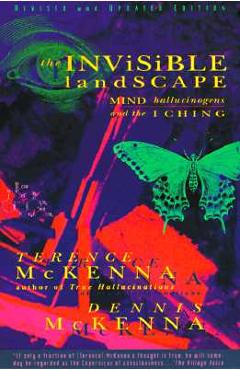The Invisible Landscape: Mind, Hallucinogens, and the I Ching - Terence Mckenna

Detalii The Invisible Landscape: Mind, Hallucinogens,
libris.ro
119.28 Lei
132.53 Lei
Body, Mind & Spirit
Terence Mckenna
The Invisible Landscape: Mind, Hallucinogens, - Disponibil la libris.ro
Pe YEO găsești The Invisible Landscape: Mind, Hallucinogens, de la Terence Mckenna, în categoria Body, Mind & Spirit.
Indiferent de nevoile tale, The Invisible Landscape: Mind, Hallucinogens, and the I Ching - Terence Mckenna din categoria Body, Mind & Spirit îți poate aduce un echilibru perfect între calitate și preț, cu avantaje practice și moderne.
Preț: 119.28 Lei
Caracteristicile produsului The Invisible Landscape: Mind, Hallucinogens,
- Brand: Terence Mckenna
- Categoria: Body, Mind & Spirit
- Magazin: libris.ro
- Ultima actualizare: 28-10-2025 01:22:05
Comandă The Invisible Landscape: Mind, Hallucinogens, Online, Simplu și Rapid
Prin intermediul platformei YEO, poți comanda The Invisible Landscape: Mind, Hallucinogens, de la libris.ro rapid și în siguranță. Bucură-te de o experiență de cumpărături online optimizată și descoperă cele mai bune oferte actualizate constant.
Descriere magazin:
Chapter OneThe Figure of the ShamanOf all the diverse religious institutions that humans have elaborated since before the beginning of recorded history, that of shamanism is one of the most singular and is probably one of the most archaic as well. The shaman is something of a maverick among religious practitioners. While shamanism occurs in virtually every culture on the planet, manifesting itself in religious traditions both ancient and modern, both primitive and sophisticated, the shaman remains eminently individualistic, idiosyncratic, and enigmatic, standing ever apart from organized ecclesiastical institutions while still performing important functions for the psychic and religious life of the culture. Comparable, but not identical, with such similar idiosyncratic practitioners as medicine men and sorcerers, the shaman is the possessor of techniques of proven efficacy and of powers bordering on the paranormal, the complete understanding of which still eludes modern psychology. It is this complex and fascinating figure of the shaman that we want to analyze from a standpoint at once sympathetic, interpretative, and psychological, with a view to answering the following questions: (1) What are the traditional aspects of shamanism as it is encountered in primitive cultures? (2) What is the nature of the shamanic personality and abilities, and what is the psychological role of the shaman in the society at large? And (3) Are there institutions analogous to shamanism in modern society?The vocation of shaman is found in nearly all archaic cultures, from the Australian aborigines to the Jivaro Indians of central Ecuador and Peru to the Yakut tribes of Siberia. It is believed to haveoriginated among these Siberian peoples, though its diffusion into other cultures must have taken place very early in prehistory for, along with sorcerers, magicians, and priests, shamanism can be counted among the oldest of professions.The word shaman is derived from the Tungusic term saman, derived in its turn from the Pali samana, indicating a possibly Southern (Buddhist) influence among these northern peoples (Eliade 1964, P. 4951). Eliade distinguishes the shaman from other types of religious and magical practitioners primarily on the basis of his religious function and techniques: ... he is believed to cure, like all doctors, and to perform miracles of the fakir, like all magicians, whether primitive or modern. But beyond this, he is a psychopomp, and he may also be

Produse asemănătoare
Produse marca Terence Mckenna

The Invisible Landscape: Mind, Hallucinogens, and the I Ching - Terence Mckenna
![]() libris.ro
libris.ro
Actualizat in 28/10/2025
119.28 Lei

Food of the Gods: The Search for the Original Tree of Knowledge a Radical History of Plants, Drugs, and Human Evolution - Terence Mckenna
![]() libris.ro
libris.ro
Actualizat in 28/10/2025
134.64 Lei

The Archaic Revival: Speculations on Psychedelic Mushrooms, the Amazon, Virtual Reality, Ufos, Evolut - Terence Mckenna
![]() libris.ro
libris.ro
Actualizat in 28/10/2025
125.9 Lei

True Hallucinations: Being an Account of the Author\'s Extraordinary Adventures in the Devil\'s Paradis - Terence Mckenna
![]() libris.ro
libris.ro
Actualizat in 05/06/2025
100.39 Lei
